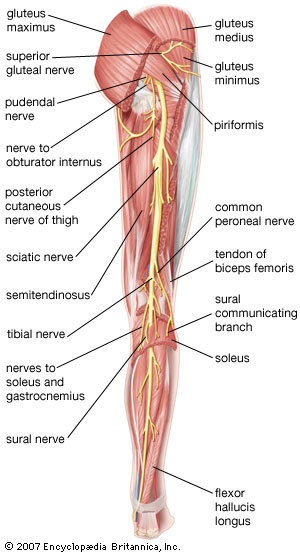leg
anatomy

 limb or appendage of an animal, used to support the body, provide locomotion, and, in modified form, assist in capturing and eating prey (as in certain shellfish, spiders, and insects). In four-limbed vertebrates all four appendages are commonly called legs, but in bipedal animals, including humans, only the posterior or lower two are so called.
limb or appendage of an animal, used to support the body, provide locomotion, and, in modified form, assist in capturing and eating prey (as in certain shellfish, spiders, and insects). In four-limbed vertebrates all four appendages are commonly called legs, but in bipedal animals, including humans, only the posterior or lower two are so called.The bones of the human leg, like those of other mammals, consist of a basal segment, the femur (thighbone); an intermediate segment, the tibia (shinbone) and the smaller fibula; and a distal segment, the pes ( foot), consisting of tarsals, metatarsals, and phalanges (toes).
For the actions of the major muscles of the mammalian leg, see adductor muscle; biceps muscle; gastrocnemius muscle; gluteus muscles (gluteus muscle); quadriceps femoris muscle; sartorius muscle; soleus muscle.
In birds and bats the foreleg has evolved into the wing. Various other adaptations of the leg include modifications for swimming, digging, leaping, and running, as seen in the porpoise, the mole, the kangaroo, and the horse, respectively. The appendages of many invertebrates are also known as legs.
- Lord George Gordon
- Lord George Murray
- lord high steward
- Lord Howe Island
- Lord Jeffrey, Francis Jeffrey
- Lord Kames, Henry Home
- Lord Lethington Maitland, Sir Richard
- Lord Menuhin of Stoke d'Abernon Menuhin, Yehudi
- Lord Monboddo, James Burnett
- Lord Norman Foster
- Lord North, Frederick North
- Lord of Misrule
- Lord Randolph Churchill
- Lord Russell, William Russell
- Lord's Cricket Ground
- Lords, House of
- Lord's Prayer
- lord steward
- Lord Strange's Men
- Lord Warriston, Archibald Johnston
- Lord William Bentinck
- Loredan, Pietro
- Lorelei
- Loren Eiseley
- Lorengau